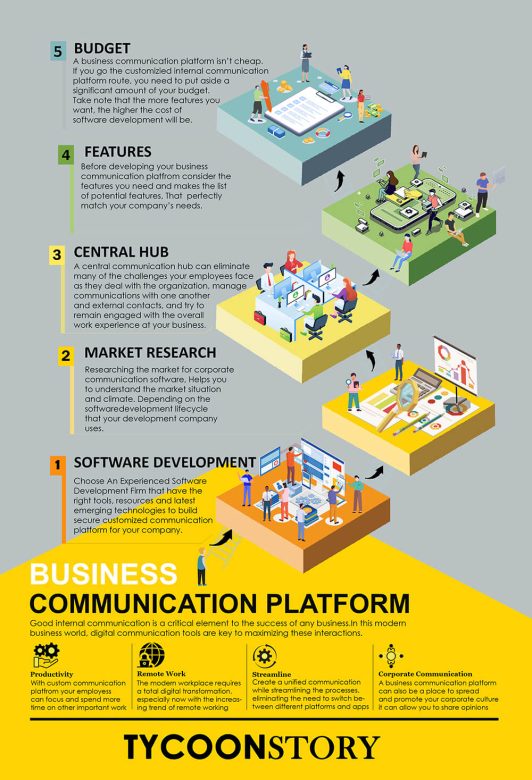Good internal communication is a critical element to the success of any business. In fact, a study has shown that employees in a modern workplace spend about 80% of their time on collaborative activities. In this modern business world, business communication platform tools are key to maximizing these interactions.
Unfortunately, most businesses suffer from fragmented, disconnected in-house platforms. A small startup with 5-10 employees can work well with regular messengers such as email or social media apps. However, as you hire new employees and establish a more branched structure, you’ll need a specialized internal communication platform—one that incorporates seamlessly into your existing processes and is custom-built according to your employees’ requirements.
In addition, you want a solution, for instance, a dialing solution, that you can incorporate into your communication platform and that allows you to seamlessly connect with your clients and customers. If you’re interested, take a look at 1800 numbers for sale by Call Cowboy.
With this comprehensive guide, we’ll talk about the benefits of a custom business communication platform and how you should go about building one from scratch.
Benefits Of An Internal Business Communication Platform
Building your communication tool can help your business in numerous ways. Here are some of the benefits of customized internal business communication software:
1. A Productivity Boost
The main reason why a business should develop a corporate communication platform is t help increase employee productivity. When communication is faster and easier, your employees can focus and spend more time on other important work. With custom software, your employees can have access to the latest updates and relevant information which can be easily accessed on any device anywhere, anytime.
If you want, you can also include collaborative tools like email inboxes or shared workspaces in your platform that provides brand new possibilities for your staff. If you have the budget, automation is another way to help boost productivity, automating and simplifying routine tasks to free up time for your employees.
2. Better Remote Employee Experience
The modern workplace requires a total digital transformation, especially now with the increasing trend of remote working, thanks to the COVID-19 outbreak. But as the pandemic starts to ease and businesses begin to open their doors once again, most organizations are now using a hybrid setup—a combination of a traditional office and remote work.
In both cases, smooth internal communication is critical for businesses, especially with a hybrid workplace. A customized communication tool can help in increasing your productivity while also streamlining existing processes.
3. More Streamlined Processes
Corporate communication usually involves several channels for different purposes. This can create communication silos and cause disconnected employees. By building a custom internal communication platform, you can create a unified communication while streamlining the processes, eliminating the need to switch between different platforms and apps.
As a result, your employees can spend less time looking for the required data and info. Instead, they can get all the current essential content in a single place.
4. Foster An Open And Transparent Corporate Culture
A custom platform for internal corporate communication helps in creating an open and friendly culture to share opinions and ideas as well as getting to know your co-workers and increasing trust and camaraderie.
When developed properly, a business communication platform can also be a place to spread and promote your corporate culture. It can allow you to post announcements, share corporate photos, hold online workshops and virtual events, or honor your staff—all of which can boost satisfaction, motivation, and inclusivity at workplaces.
How To Create A Business Communication Platform 1. Choose An Experienced Software Development Firm
1. Choose An Experienced Software Development Firm
Unless you’re a programmer with a rigorous software development background, developing your communication platform means you need to hire or outsource a software development firm to build a communication platform.
As the one responsible for building your communication software, you want someone with enough knowledge. Consider asking for past projects and whether they have experience building the solution you need. Check their track record and read reviews and testimonials about their services.
The best software development firm should have the robust tools and resources needed to develop a customized communication platform for your company. For example, Airdev uses the latest technologies and programming languages, such as bubble development, to help build secure and scalable software products.
In addition, software development can take months to complete. So, you want a company that has seamless and transparent communication and constantly updates you on the progress of the project.
2. Do Your Research
Once you find the right development to partner with, you can start conducting research with them. As with every project, you need to start your business communication platform development with thorough planning. You and your developer should thoroughly research the market situation and climate. Depending on the software development lifecycle that your development company uses, the process will vary.
In general, though, researching the market for corporate communication software requires you to answer these key questions:
What Are Your Business Needs For A Communication Platform?
A custom business communication platform allows you to perfectly tailor it according to your business needs. So, the question now is what are those needs?
To understand your business needs, consider the who, what, and how.
Who will use the software? Is it for specific departments or a company-wide solution? How will your employees use it? Do they need a simple group chat application to stay connected and share company news? Do you need a project management or collaboration tool for a few specific departments to access and share ideas and information? Perhaps you need something special like a communication solution for your top managers and board members? Or maybe you want it all?
Do You Need A Web Solution, Mobile App, Or Both?
Once you’ve determined your needs, you need to decide whether to choose a web/mobile-only solution or plan to cover both for enabling business communications.
In general, the traditional office is made up of desktop computers and laptops. Thus, most digital communication solutions for businesses are often web-based. That said, with the increasing popularity of remote working, mobile-first apps have also increased significantly.
In most cases, even a web-based platform should be mobile-friendly these days. However, it’s best to develop both (provided you have the budget), allowing you to cater to a hybrid workplace.
What Are Your Success KPIs?
Setting clear success KPIs allows you to get a better understanding of the best features you need to achieve them. The exact list of metrics you need to set will depend on your business needs. However, in general, success KPIs of an effective business communication platform may include:
a. Engagement Metric
This refers to how employees will interact with the platform and are engaged in corporate and social communication activities. For instance, it may include open, reply, click, and other relevant metrics.
b. Behavioral Metric
This refers to how the solution influences the behaviors, attitudes, and opinions of employees. This may include the level of satisfaction and trust, average response rate, and more.
c. Productivity Metric
This refers to how the platform boosts productivity and employees within the company. Some examples may include how much time is saved because of improved internal communications or how faster communication and collaboration go.
Take note that more questions will occur during the research stage. Most development firms can help you outline everything there is to know about a project at the first stage of development. So, take your time discussing your options and needs with your chosen development company.
3. Establish A Central Hub
Any effective internal communication tool requires a central hub, serving as the foundation for your collaboration and communication needs.
In this case, consider using an intranet. It acts as a centralized digital workplace hub for your employees, integrating all existing systems. It also makes it easier for your admin staff to manage communication and content while making it more convenient for the rest of your employees to find the necessary information and connect with each other.
It allows a place where all collaboration and communication can start and allow users to connect on three different levels—personal, local, and global.
In general, your software development may help you in setting up your company’s intranet, in line with your communication platform development.
4. Consider The Features You Need
We’ve mentioned before that developing your communication platform allows you to perfectly match your company’s needs. Thus, its functionality can also be tailored. This makes the list of potential features quite large.
Below are some of the most common features of an internal communication platform. Take note that the more features you have, the higher the cost of software development will be.
a. Onboarding
The idea behind onboarding is to help guide users, showing what the main features are and how to use them. As you build a communication platform, you can implement an onboarding process in different ways such as a short introductory video or a few screenshots of the platform and its key features.
b. Profiles
Internal communication is based on transparency. Thus, you want your employees to be able to log in and identify themselves. The signup process shouldn’t be different from other apps where users can provide their email or phone number. Or you can choose to let your admins create employee profiles. Their profile must include the necessary information such as photo, name, department, position, contact details, and non-work info such as hobbies, which can be useful in improving employee relationships.
c. Feed
This is where all information—announcements, achievements, current projects, corporate life updates, and more—will be posted. You should include functionality that allows you to pin important announcements so everyone can see them. You can also include a filtering system so employees can sort posts by relevance.
d. Library
One of the key communication issues for employees is finding the right files. Having a library of shared files can help your employees store everything in a single place and access it whenever they need it.
e. Groups
This feature is necessary to help specific departments create a dedicated group to share team-specific information. Announcements and other information can be posted so that only group members can see and access them.
f. Chat And Video Call
Instant messaging and video calling functionality is a must for any modern business communication platform. It’s critical to have direct messaging features between users. The video call feature also allows remote teams to hold virtual meetings and conferences.
g. File Sharing
This is necessary for all business communication. Depending on your business needs, sharing one type of file may be enough, but it’s better if your platform can support multiple file types.
h. Notifications
Notifications are necessary to ensure that employees don’t miss any important messages or announcements when the app is running in the background.
i. Admin Controls
Admin control is an important security feature. It allows you to assign an administrator that monitors internal communications, adds or removes employees, changes access levels, and more.
j. Integrations
The option of being able to add and integrate third-party apps allows for a seamless fit with your existing solution. It also helps save on costs. For instance, instead of developing a feature for collaborative document editing, you can simply integrate existing services you already use like Dropbox or Office 365.
5. Set A Budget
A business communication platform isn’t cheap. If you go the custom route, you need to put aside a significant amount of your budget. In general, your developer can help in planning your platform to fit your set budget.
That said, here are some factors that affect communication development:
- Types of experts you need (project manager, android/iOS developer, web developers, etc.)
- Development duration
- Functionality and feature
- Design (pre-made interface or made from scratch)
- Platforms (web-based or mobile app)
Takeaway
Business communication continues to evolve as social connectivity changes. Today, to build a transparent and collaborative business environment, a dedicated business communication platform is more critical than ever.
This is why business communication software development is becoming more popular to provide your employees a platform that’s designed specifically for their needs as well as perfectly matching your existing workflows—something that pre-made solutions can hardly offer.
With a customized internal corporate communication tool, your business can take advantage of numerous benefits, specifically increased overall productivity. And a business with productive employees is a successful organization.


 1. Choose An Experienced Software Development Firm
1. Choose An Experienced Software Development Firm
